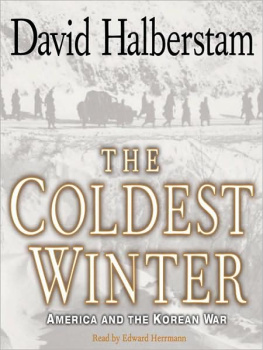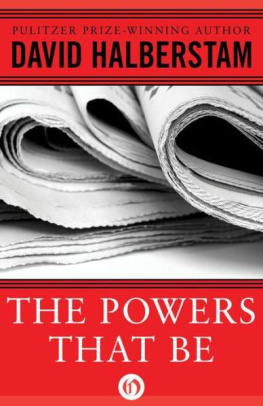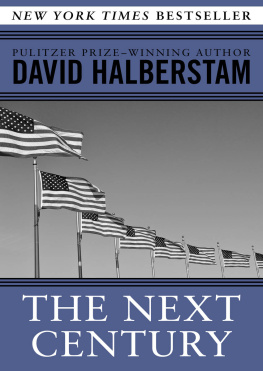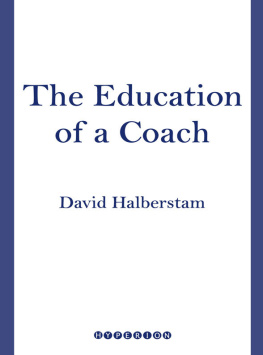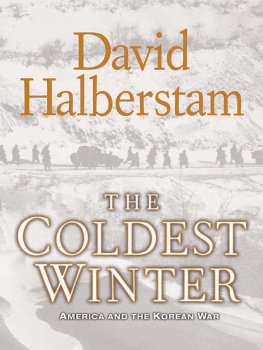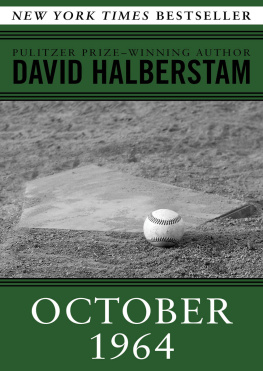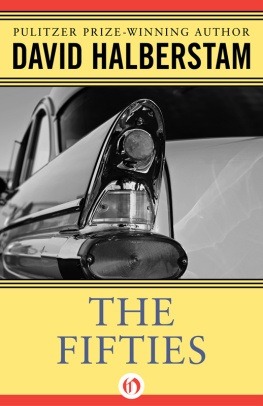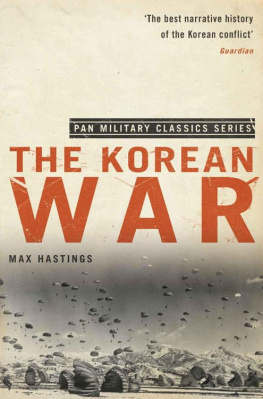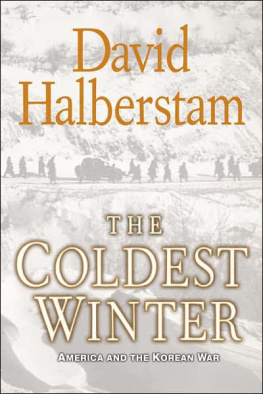The Coldest Winter
America and the Korean War
DAVID HALBERSTAM
For Jean, again
Contents
Glossary of Military Terms
List of Maps
Note on Military
Map Symbols
Introduction
PART ONE: A Warning at Unsan
PART TWO: Bleak Days: The In Min Gun Drives South
PART THREE: Washington Goes to War
PART FOUR: The Politics of Two Continents
PART FIVE: The Last Roll of the Dice: The North Koreans Push to Pusan
PART SIX: MacArthur Turns the Tide: The Inchon Landing
PART SEVEN: Crossing the Parallel and Heading North
PART EIGHT: The Chinese Strike
PART NINE: Learning to Fight the Chinese: Twin Tunnels, Wonju, and Chipuongni
PART TEN: The General and the President
PART ELEVEN: The Consequences
Epilogue
Author's Note
Acknowledgments
Afterword by Russell Baker
Notes Bibliography Searchable Terms About the Author Other Books by David Halberstam Copyright Glossary of Military Terms
NOTE ON MILITARY UNITS The size, composition, and leadership of military units varies with time, place, and circumstances. In the early fighting in Korea, almost every unit was always under strength. Therefore, these numbers are approximations.
Army 100,000 soldiers Comprised of 2 or more Corps Normally commanded by a full General Corps 30,000 soldiers Comprised of 2 or more Divisions Normally commanded by Lieutenant General Division Up to 15,000 soldiers, often only 12,000 in Korea Comprised of 3 Regiments Commanded by Major General Regiment Up to 4,500 men, with affiliated units, such as artillery, armored, and medical units, included Comprised of 3 Battalions Commanded by Colonel Battalion 700 to 850 soldiers Comprised of 4 or more Companies Commanded by Lieutenant Colonel Company 175 to 240 soldiers Comprised of 4 Platoons Commanded by Captain Platoon 45 or more soldiers Comprised of 4 Squads Commanded by Lieutenant Squad 10 or more soldiers Commanded by Staff Sargeant WEAPONS AND ARTILLERY M-1 Rifle A 9.5-lb. rifle, with an 8-round .30-caliber clip, the basic American infantry-weapon.
Carbine A short-barreled rifle with a .30-caliber 15-or 30-round clip with less range and accuracy.
Browning Automatic A two-man weaponone Rifle, or BAR .30-caliber Machine Guns to feed ammunition, one to firethat was both semi-and fully automatic, capable of firing 500 rounds a minute.
The .30-caliber machine guns were capable of sustained fire of 450 to goo rounds a minute.
The .50-caliber gun was mounted on trucks, tanks, and other vehicles. It fired 5 rounds per minute to a range of 2,000 yards.
Rocket Launcher The ineffective 2.36-inch or Bazooka launcher was replaced by 2.36-inch and 3.5-the 3.5-inch in 1950 even inch as the North Koreans drove south. The new bazooka was capable of penetrating thick armor plate; it had a range of up to 75 yards.
These front-loaded weapons fired shells at a high angle, able to reach into valleys and trenches, with a range of 1,800 to 4,000 yards.
Infantry Mortars .60mm .81mm 4.2mm Howitzers 105mm 155mm 8-inch Cannons with a range of 2 to 5 miles.
List of Maps
The Korean Peninsula before Hostilities. May 1950
First Encounter with Chinese Communist Forces November 1, 1950
The Unsan Engagement. November 12, 1950
The North Korean Invasion, June 2528, 1950
Task Force Smith, July 5,1950
Height of North Korean Advance. Late August 1950
7. The Pusan Perimeter. August 4, 1950
8. The Naktong Bulge, August 31September 1, 1950
9. The Inchon Landings. September 15, 1950
The Drive to Seoul. September 1628,1950
UN Breakout and Invasion of North Korea
Chinese Attack at Chongchon River, on Second Division. November 2526,1950
Chinese Assault on Love Company. November 25-26,1950
The Main Chinese Campaign in the West. November 25-28,1950
The Marine Sector. OctoberNovember 27, 1950
The Gauntlet, November 30, 1950
Breakout from Chosin Reservoir, November 27December 9, 1950
High Tide of the Chinese Advance, January 1951
19. The Fight for the Central Corridor
The Twin TunnelsChipyongni-Wonju Area, JanuaryFebruary 1951
Battle of Twin Tunnels, January 31February 1, 1951
Battle of Chipyongni, February 1314, 1951
McGee Hill. February 13-15. 1951
Task Force Crombez. February 1415. 1951
The Korean Peninsula after the Cease-fire, July 27.
Note on Military Map Symbols
Every effort has been made to update the maps in The Coldest Winter to a modified version of the standard MIL-STD-2525B common warfighter symbology used by the U.S. Military. This is a comprehensive system that gives a trained interpreter instant information about a military unit's alignment, size, type, and identity.
In some cases, complete information was not available for specific military units, and rather than introduce inaccuracies, an easily legible shorthand has been applied. With clarity in mind, other modifications that aren't standard MIL-STD-2525B have been made to improve readability.
While MIL-STD-2525B accounts for hundreds of military designations, only a few are necessary to understand the units employed in the Korean War.



The name of the unit can be displayed to the left of the unit symbol, the name of the larger group it is part of appears to the right of the unit symbol, and the size of the unit is indicated by the marking at the top. For example, the symbol for the Third Battalion of the Eighth Cavalry is:
Unless otherwise noted, a solid black line represents U.N. positions or a defensive perimeter.
The Coldest Winter

Introduction
On JUNE 25, 1950, nearly seven divisions of elite North Korean troops, many of whom had fought for the Communist side in the Chinese civil war, crossed the border into South Korea, with the intention of conquering the entire South in three weeks. Some six months earlier, Secretary of State Dean Acheson, in a colossal gaffe, had neglected to include South Korea in America's Asian defense perimeter, and the only American forces then in the country, part of a tiny advisory mission, were almost completely unprepared for the attack. In the early weeks of the invasion, the Communist offensive was a stunning success. Every bit of news from the battlefield was negative. In Washington, President Harry Truman and his top advisers debated the enemy's intentions. Was this, as they greatly feared, an assault ordered up by the Russians? Were the North Koreans nothing but Moscow's pawns? Or was it a feint, the first in a series of what might be provocative Communist moves around the world? They quickly decided to use United States, and in time United Nations, forces to draw a line against Communist aggression in Korea.
The Korean War would last three years, not three weeks, and it would be the most bitter kind of war, in which relatively small American and United Nations forces worked to neutralize the superior numbers of their adversaries by the use of vastly superior hardware and technology. It was a war fought on strikingly harsh terrain and often in ghastly weather, most particularly a numbing winter cold that often seemed to American troops an even greater enemy than the North Koreans or Chinese. "The century's nastiest little war," the military historian S. L. A.
Marshall called it. The Americans and their United Nations allies faced terrible, mountainous terrain, which worked against their advantage in hardware, most notably their armored vehicles, and offered caves and other forms of shelter to the enemy. "If the best minds in the world had set out to find us the worst possible location to fight this damnable war politically and militarily, the unanimous choice would have been Korea," Secretary of State Acheson said years after it was over. "A sour war," Acheson's friend Averell Harriman said of it.

